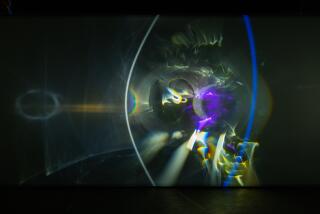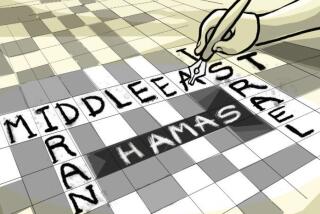For Iranian American artist Ardeshir Tabrizi, a fractured sense of identity
- Share via
Ardeshir Tabrizi’s mixed-media paintings resemble ruins: beautifully crafted artifacts ravaged by time, their condition speaking of past grandeur that can only be imagined.
His six paintings in “Masjid” (Arabic for mosque) at Roberts Projects in Culver City also look unfinished, their sections of bare canvas and the gaps in their patterns suggesting he abandoned them before he completed them.
It started as a promising California art biennial. It’s now a partnership with a government linked to human rights abuses and the killing of a journalist.
That ambiguity packs a punch. It makes Tabrizi’s paintings feel as if they do not inhabit the present so much as they are haunted by a past that has all but vanished and a future that will never be more than a fantasy.
It is as if his fragmented works, combining acrylic ink, embroidered silk imagery and stitched cotton line work, are refugees. That term usually refers to people subjected to geographic displacement. In contrast, Tabrizi’s paintings embody a sense of temporal dislocation. They give form to the fractured reality people inhabit when the present is out of sync with everything that came before it.
Tabrizi’s multilayered works look like three or four images superimposed. The loosely brushed grounds of pearlescent ink — in soft shades of sky blue, sand and pale green — have the presence of well-worn, sun-faded garments. The single images in their centers are borrowed from Persian myths and take the form of icons. The elaborate, all-over patterning recalls Persian rugs, but the pictures and symbols Tabrizi has inserted are anathema to the image-free abstraction of traditional geometric patterning.
The parts of his paintings do not add up to wholes. Instead, they suggest conflicting perspectives, divergent expectations and different histories. The same is true of his 12 framed drawings, which cover a wall in the gallery office. Each collaged, stitched, painted and drawn work embodies the internal conflict we feel when we are of two minds about something.
That complexity mirrors Tabrizi’s life. Born in Tehran in 1981, his family left in 1986 during the Iran-Iraq War. After moving around Europe, they settled in Los Angeles, where Tabrizi has experimented with photography, video and painting.
His new works are an object lesson in the power of seeing reality from different points of view, none complete or capable of capturing the whole truth. Each is richer for being part of the ongoing, polyglot conversation.
Ardeshir Tabrizi
Where: Roberts Projects, 5801 Washington Blvd., L.A.
When: Tuesdays-Saturdays, through Nov. 16
Info: (323) 549-0223, www.robertsprojectsla.com
Support The Times’ coverage of L.A. artists. Please consider a digital membership.
More to Read
The biggest entertainment stories
Get our big stories about Hollywood, film, television, music, arts, culture and more right in your inbox as soon as they publish.
You may occasionally receive promotional content from the Los Angeles Times.

![LOS ANGELES, CA - JUNE 17: [Cody Ma and Misha Sesar share a few dishes from their Persian Restaurant Azizam] on Monday, June 17, 2024 in Los Angeles, CA. (Ethan Benavidez / For The Times)](https://ca-times.brightspotcdn.com/dims4/default/7ffc7f6/2147483647/strip/true/crop/5110x3417+306+0/resize/320x214!/quality/75/?url=https%3A%2F%2Fcalifornia-times-brightspot.s3.amazonaws.com%2F79%2Fdc%2F4d29255545f5b9813315901692bc%2F1459972-fo-azizam-review20-eba.JPG)








